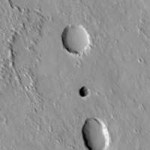Mars
Mars Orbiter has captured thousands of images in high resolution from the surface of the Grumpy Reddish Planet. The picture you see here is a chain of pit craters. That must have been one helluva noisy event. Reminds me of the walls at the Entebe Airport.
Anyway, the High Resolution Imaging Science Experiment (HiRISE) camera takes pictures that are about 6 km wide and some greater amount long, wiht resolution down to as small as one meter. The pictures are being released a few at a time and you can access them here.
There are even 3D images but you will need special glasses to see…
I notice that the NOVA documentary, Is there life on Mars?, is viewable online (from December 2008). Check it out.
Look closely at this picture of Victoria Crater on Mars. Clicking on the picture will give you a really big file, but a much better look. There are a number of things you can see in this view of Victoria that you could not see on earlier version because this is a somewhat oblique view. The details are in the press release I reproduce below the fold. But the other thing you can see that is REALLY FREAKIN' COOL is the mars rover tracks running along one side of the crater! Go ahead, see if you can find them!
Mars Orbiter Shows Angled View of Martian Crater
TUCSON, Ariz. -- The high-…
Starting today and going until early August, you might see fewer posts on Eruptions than you're accustomed. This is because I'm in the process of moving to Ohio to get set up to start my new job as an assistant professor at Denison University. I'm excited about the move, but as you can imagine, trying to pull up stakes in California and trek two-thirds of the way across the continent will take up a lot of my time. I will miss the easy access to volcanoes here on the Left Coast, but I am excited to get (mostly) permanent employment, set up my own lab and to be able to teach geology again!…
The mission was temporarily interrupted when the computer inexplicably rebooted. Perhaps they should have used Linux on the embedded Power PC hardware, rather than the proprietary system they did use. From a NASA press release:
PASADENA, Calif. -- NASA's Mars Reconnaissance Orbiter is examining Mars again with its scientific instruments after successfully transitioning out of a precautionary standby mode triggered by an unexpected June 3 rebooting of its computer.
Engineers brought the spacecraft out of the standby mode on June 6. Cameras and other scientific instruments resumed…
NASA researchers is now reporting in the May 21st issue of Nature that water could remain liquid at sub-freezing temperatures if made stable against freezing by containing dissolved minerals. From the abstract:
Many features of the Martian landscape are thought to have been formed by liquid water flow, and water-related mineralogies on the surface of Mars are widespread and abundant. Several lines of evidence, however, suggest that Mars has been cold with mean global temperatures well below the freezing point of pure water. Martian climate modellers, considering a combination of greenhouse…
The Mars rover Opportunity has explored Victoria crater, a ~750-meter eroded impact crater formed in sulfate-rich sedimentary rocks. Impact-related stratigraphy is preserved in the crater walls, and meteoritic debris is present near the crater rim. The size of hematite-rich concretions decreases up-section, documenting variation in the intensity of groundwater processes. Layering in the crater walls preserves evidence of ancient wind-blown dunes. Compositional variations with depth mimic those ~6 kilometers to the north and demonstrate that water-induced alteration at Meridiani Planum was…
A computer model of the formation of Olympus Mons (a big giant mountain on Mars) indicates that this geological formation should contain pockets of water.
The scientists explained that their finding is more implication than revelation. "What we were analyzing was the structure of Olympus Mons, why it's shaped the way it is," said McGovern, an adjunct assistant professor of Earth science and staff scientist at the NASA-affiliated Lunar and Planetary Institute. "What we found has implications for life - but implications are what go at the end of a paper."
This water would be liquid. Warm, in…
Last month, the UK Government came up with an ingenious new idea to stem the rising tide of obesity that is already spilling over low-slung jeans everywhere: eat less. Health Minister Alan Johnson met with a coalition of confectionery giants including Mars, Coca-Cola and Nestle, urging them to reduce the sizes of their delicious, calorie-laden snacks.
Shrinking portions is not a new idea. Last year, Food Standards Agency formed a panel to explore the role of food portion in our diets after announcing that reducing portions would be one of four key proposals for encouraging healthier…
For over six months, Veronica McGregor has been Twittering from Mars.
Of course, she's not living among the wind storms and dirt of the red planet herself, but she is the voice of MarsPhoenix, the strangely compelling, first-person, lonely robot Twitter feed that somehow became the official mouthpiece of NASA's Phoenix mission and has catalyzed an entirely new kind of public involvement in science.
MarsPhoenix is followed by over 37,000 people online, and provides daily updates on Martian weather conditions, scientific discoveries, as well as pithy observations about our role in the…
tags: mars, Martian Sand Dunes, NASA, astronomy, Image of the Day
Cool Shot of Thawing Sand Dunes Near Martian Polar Region.
Image: NASA. [larger size].
People love to speculate that Mars was once a great place for life to form, and claim that there is plenty of evidence that there used to be oceans and rivers there. But this isn't true. People used to claim there were big Canal-like features on Mars, and used this as evidence that Mars was very wet.
It was later realized that these weren't canals, but rather geological features caused by impact craters from astroids. But more recently, people have been claiming that images like the one above are examples of dried-up riverbeds.
But this turns out not to be the case. When we take a closer…
This is just one of dozens of responses to common climate change denial arguments, which can all be found at How to Talk to a Climate Sceptic.
Objection:
Global warming is happening on Mars and Pluto as well. Since there are no SUV's on Mars, CO2 can't be causing Global Warming.
Answer:
Warming on another planet would be an interesting coincidence, but even if it were the case it does not necessarily have to have the same cause. The only relevant factor the Earth and Mars share is the sun, so if the warming were real and related it would logically be due to the sun. Well the sun is being…


